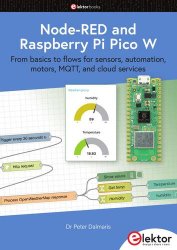Node-RED and Raspberry Pi Pico W : From basics to flows for sensors, automation, motors, MQTT, and cloud services
- Добавил: literator
- Дата: 2-02-2024, 15:09
- Комментариев: 0
 Название: Node-RED and Raspberry Pi Pico W : From basics to flows for sensors, automation, motors, MQTT, and cloud services
Название: Node-RED and Raspberry Pi Pico W : From basics to flows for sensors, automation, motors, MQTT, and cloud servicesАвтор: Peter Dalmaris
Издательство: Elektor International Media B.V.
Год: 11 January 2024
Страниц: 528
Язык: английский
Формат: pdf (true)
Размер: 41.9 MB
From basics to flows for sensors, automation, motors, MQTT, and cloud services.
This book is a learning guide and a reference. Use it to learn Node-RED, Raspberry Pi Pico W, and MicroPython, and add these state-of-the-art tools to your technology toolkit. It will introduce you to virtual machines, Docker, and MySQL in support of IoT projects based on Node-RED and the Raspberry Pi Pico W.
This book combines several elements into a platform that powers the development of modern Internet of Things applications. These elements are a flow-based server, a WiFi-enabled microcontroller, a high-level programming language, and a deployment technology. Combining these elements gives you the tools you need to create automation systems at any scale. From home automation to industrial automation, this book will help you get started.
Node-RED is an open-source flow-based development tool that makes it easy to wire together devices, APIs, and online services. Drag and drop nodes to create a flowchart that turns on your lights at sunset or sends you an email when a sensor detects movement. Raspberry Pi Pico W is a version of the Raspberry Pi Pico with added 802.11n Wi-Fi capability. It is an ideal device for physical computing tasks and an excellent match to the Node-RED.
Quick book facts:
Project-based learning approach.
Assumes no prior knowledge of flow-based programming tools.
Learn to use essential infrastructure tools in your projects, such as virtual machines, Docker, MySQL and useful web APIs such as Google Sheets and OpenWeatherMap.
Dozens of mini-projects supported by photographs, wiring schematics, and source code. Get these from the book GitHub repository.
Step-by-step instructions on everything.
All experiments are based on the Raspberry Pi Pico W. A Wi-Fi network is required for all projects.
Hardware (including the Raspberry Pi Pico W) is available as a kit.
Part 1 is dedicated to Node-RED for the absolute beginner. In Part 1, you will learn about Node-RED and event-driven systems, how to install an instance using the Docker option, the basics of nodes and flows, the dashboard and MQTT. If you are new to Node-RED, read the chapters in Part 1 carefully and complete the various projects.
Part 2 brings the Raspberry Pi Pico W into the mix. In the chapters of Part 2, you will learn how to use the Pico W as a Node-RED peripheral. You will learn to use MQTT to enable communications between the Pico and the Node-RED instance. You will also learn how to connect different hardware components to the Pico to implement simple circuits and use Node-RED (and its Dashboard) to control these components or view the data they produce.
Part 3 provides a primer to MicroPython. MicroPython is a language specifically designed for embedded systems using Python 3 syntax. Python 3 is one of the most successful programming languages ever. Python's syntax is straightforward, making it easy for beginners to learn. This simplicity encourages good programming practices and allows for a focus on problem-solving rather than syntax issues. MicroPython brings those attributes to Microcontroller programming. If you are not familiar with Python or MicroPython, the chapters in Part 3 will help you learn everything you need to be able to confidently write MicroPython programs for the Raspberry Pi Pico (and Pico W), as well as any other of the many Microcontroller boards that support MicroPython.
Finally, Part 4 provides additional Node-RED resources. These resources consist of content on important Nodes (all explained with the help of mini-projects), control structures, and ways to integrate your Node-RED flows with external services and APIs. In Part 4, you will learn how to create power flows that can be used in more advanced automation settings.
Скачать Node-RED and Raspberry Pi Pico W : From basics to flows for sensors, automation, motors, MQTT, and cloud services
[related-news] [/related-news]
Внимание
Уважаемый посетитель, Вы зашли на сайт как незарегистрированный пользователь.
Мы рекомендуем Вам зарегистрироваться либо войти на сайт под своим именем.
Уважаемый посетитель, Вы зашли на сайт как незарегистрированный пользователь.
Мы рекомендуем Вам зарегистрироваться либо войти на сайт под своим именем.
